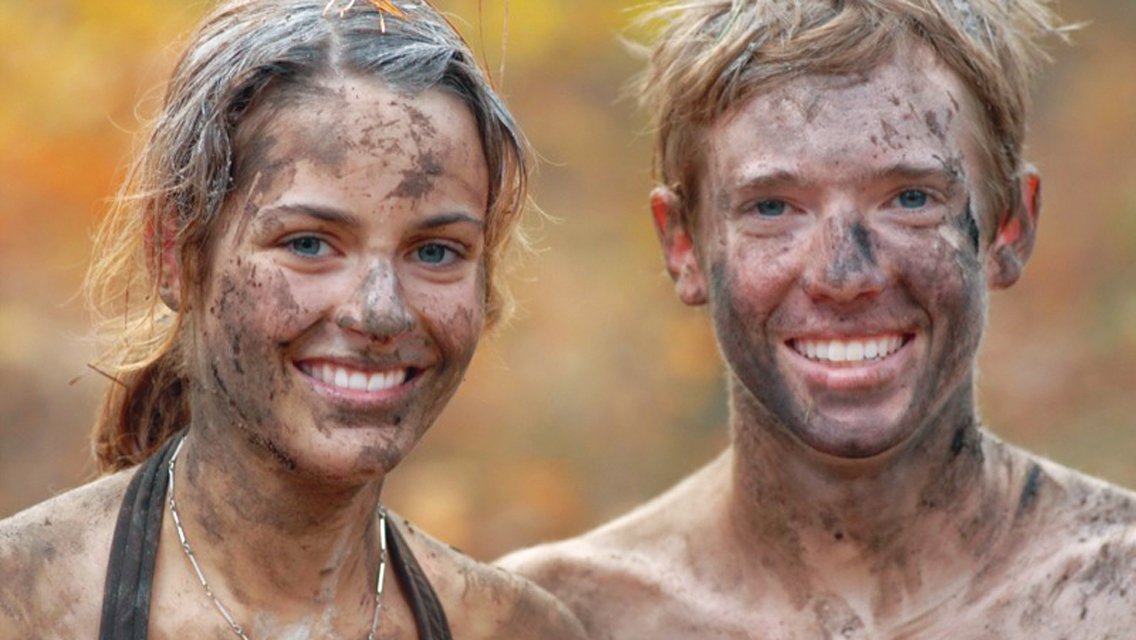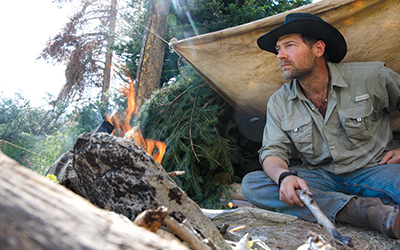Sheri Webb moves stealthily through northern California’s Mount Shasta Wilderness, taking care not to step on twigs or crackling leaves. She pauses every few minutes to pick miner’s lettuce for food or to scrutinize a print on the ground. Is it a deer trail? Will it lead to a spring where she can drink?
For 36 hours last spring, Webb and her boyfriend, Frank Sturniolo, made themselves at home in this pristine forest, with only a knife, a flint, a canteen and a cup. It was the culmination of a six-day outdoor survival course called The Edge — a course that the outfitter, Lifesong Wilderness Adventures, patterned after the TV series Man vs. Wild. Their goal: Survive without the trappings of civilization. No cell phone, no Starbucks, no running water.
“When I hike, I normally tromp mindlessly through the woods,” admits Webb, 32, a nurse from San Diego. “In the hospital ER, survival is about speed. The Edge course slowed me down and taught me details like finding where clean water trickles out of the ground.”
After four days in a primitive tent camp learning wilderness skills, their instructors left Webb and Sturniolo to fend for themselves. The night temperature became Webb’s nemesis. “Even with a roaring fire, one side of me always froze,” she recalls. “And we didn’t pile enough pine needles in our bed to insulate us from the ground, so we were ice cubes.”
At 2 a.m., a shivering Webb yelled for help. “The instructors didn’t come because they wanted me to feel cold, hunger and panic, so if I was really lost, I’d know this was discomfort, not life or death,” she says. In the end, she was grateful she stuck it out. “The experience was scary, but empowering. It boosted my self-confidence outdoors.”
Outside the Comfort Zone
Wilderness skills courses are more popular than ever, in part because of TV survival shows and films such as Into the Wild. While most people won’t be marooned on a deserted island, many want to develop the kinds of skills and courage needed to feel at home in the wild.
“People want to be more self-reliant and learn to find edible plants, read the weather, track animals, and make their own tools and shelters,” says Tony Nester, the director of Ancient Pathways, a desert survival school in Flagstaff, Ariz.
Embarking on a wilderness survival adventure is no laid-back vacation, though. These demanding getaways teach skills that will keep you alive in extreme conditions in the desert, the mountains or in 10 feet of snow. Courses range from one-day outdoor classes that cover emergency preparedness to 28-day simulations of a wilderness worst-case scenario. Some survival-trip outfitters offer tent camping and prepared meals; others teach you to forage and sleep in dirt-and-leaf beds. Some excursions involve moderate activity; others are so physically and mentally grueling that they require a doctor’s permission.
When selecting a trip, take stock of your personal appetite for adventure, and keep in mind that wilderness travel always carries a risk of injury or death, even when monitored by experienced instructors.
Touching Nature
Why bother with old-fashioned survival skills like making and using a bow-drill to start a fire when we have modern-day conveniences (lighters, high-tech matches) at our fingertips? Tom Brown Jr., founder of the legendary Tracker School, argues that discovering outdoor skills brings us closer to nature — and ourselves.
“Primitive wilderness training gives us the knowledge to survive in any place with what we find in nature, and it gets us in touch with our ancestral roots,” says Brown, who was taught by an Apache elder. He passes on the wisdom to students who learn stalking, nature observation, edible plant identification and Native American earth philosophy in his classes in the New Jersey Pine Barrens and in Boulder Creek, Calif.
“Tracking and awareness open people’s minds and hearts to the wilderness — even the one in your backyard,” Brown says. “People begin to read animal tracks like a book. They see more wildlife and biosystems than ever before. They develop a commitment to Mother Earth.”
Without wilderness knowledge, we are aliens on our own planet, Brown maintains. “If you’re lost, you’re like a scuba diver without oxygen,” he says. By contrast, those who complete his workshops feel at home in the bush, even without fancy gadgets. “Living off the land awakens the adventure in people and inspires them to seek new horizons.”
True Grit
At age 27, Jimmy Ngo, a tech-support manager from Firestone, Colo., was burned out. “I’d lose my temper when people complained their email didn’t work,” he says. “I didn’t so much need a survival school as some perspective.” He found both during the Boulder Outdoor Survival School’s (BOSS’s) seven-day, ultrarigorous Field Course.
During the two-day “impact” phase in the dry Utah backcountry, Ngo and his group had no food or water other than what they scavenged. They carried only a knife as they hiked 20 to 30 miles in the heat, and they shivered from cold at night. “We didn’t find water for a long time, and I was losing it,” he explains. “I silently cursed the instructors because I wanted to quit. Then I thought, ‘Why am I blaming them? I willingly put myself in this situation, and if I do quit, I’m still going to have to walk out of here.’ Eventually I convinced myself I’d be OK if I just kept pushing forward.”
Ngo made it to the spot where a backpack with food, water, a poncho and a wool blanket waited. The rest of the course involved rigorous hiking and twice-daily oatmeal or grain meals, but now Ngo concentrated on mastering skills that would ease the hardship he’d just experienced. Over the week, he lost 30 pounds from the physical effort (not an uncommon occurrence, according to BOSS instructors), but he gained a new appreciation for his tenacity.
“I was humbled by how little I knew about keeping myself alive in a survival situation,” Ngo admits. “Getting back to basics made me realize we don’t need a lot of stuff in the wilderness to survive. I learned to focus on staying warm and dry and on finding food and water.”
Now, Ngo thinks he’s more patient — especially with those pesky email problems. “The experience also taught me not to overdo things: not to overeat, not to overcompensate, not to get upset over little things,” he adds. In the years since, he’s enrolled in first-aid training and completed other BOSS courses, including star navigation.
Why endure an ordeal like Ngo’s? “Fear comes from not knowing,” says Jeff Sanders, BOSS’s Utah field director. “When you freak out, things go badly. However, if experience teaches you that you can live a long time without food — and some time without water — then you don’t have to panic.”
Loving the Wilderness
The more you know about your place in nature, the less gear you need to carry with you to be safe — and even comfortable — in the wild. During his winter courses in Montana, Wilderness Arts Institute educator David Cronenwett challenges students to start a fire in 10 minutes with just one match and foraged wood. They can warm their hands at the group “backup” fire between trial runs. “It’s good to practice outdoor skills in the field, not just in your yard where conditions are less extreme,” he says.
Ultimately, the goal of instructors like Cronenwett is to help students respect nature, not fear it. Though a wilderness survival course might seem to focus on lost-in-the-woods, “man vs. wild” scenarios, it actually enhances the outdoor experience by helping you connect with nature, rather than facing off against it.
“The more you realize how much we humans depend on the land and landscape around us, the more you come to see that people aren’t separate from the rest of nature,” says Ancient Pathways’ Tony Nester. “We’re all part of that whole.”
Survival School Search
Whether you sail, hike or ski, you’ll enjoy nature more by being prepared. When selecting a wilderness-skills course, consider these factors:
- Length and level of training. One- or two-day courses offer an outdoor-preparedness overview, whereas longer courses (four days to three weeks) delve deeper so you can hone real skills.
- Physical challenge. At minimum, you must be able to hike a few miles a day with a light pack. For rigorous or high-altitude trips, train in advance for several months. Courses that simulate emergency hardships (hunger, thirst, extreme temperatures) require physical and mental prep.
- Terrain and conditions. Most courses teach skills that focus on deserts, mountains, woodlands or extreme weather conditions. Consider a course that supports your favorite activities (winter safety for skiers, summer survival for backpackers).
- Cost. Outfitters charge $100 to $200 per day. Budget for extras such as a knife, compass or metal drinking container, but don’t count on a lot of additional gear.
Resources
Check the Wilderness Drum Web site for a state-by-state list of outdoor schools: www.wildernessdrum.com/html/survival_schools.html.
Ancient Pathways: Featuring orienteering, plant uses and desert survival in Arizona, this school offers coed and women-only courses. 928-526-2552; www.apathways.com.
Boulder Outdoor Survival School (BOSS): Teaches survival skills during physically demanding courses that range from one to 28 days in Utah, Colorado and Mexico. 303-444-9779; www.boss-inc.com.
Lifesong Wilderness Adventures: Offers survival and wilderness education camps for all experience levels in remote California. 530-859-0539; www.lifesongadventures.com.
Tracker School: Wilderness expert Tom Brown Jr. shares his knowledge and philosophy during multiday workshops in New Jersey and California. 609-242-0350; www.trackerschool.com.
Wilderness Arts Institute: Learn the basics of cold-weather survival during one- to five-day courses in the Montana backcountry. 406-590-8070; www.wilderness-arts.com.
National Outdoor Leadership School (NOLS): This nonprofit wilderness education organization leads courses around the world, from New Zealand to Baffin Island in Canada. 800-710-6657; www.nols.edu.
Urban Survival
Wilderness skills such as shelter construction, attention to surroundings and keeping calm can help in urban areas, too. Tom Brown Jr., author of Tom Brown’s Field Guide to City and Suburban Survival (Berkley, 1986) and founder of the Tracker School, suggests ways to stay safe in any situation. Scenario No. 1: The power goes off in a blizzard and there’s no heat or electricity for three days. Survival Tactics: Stock nonperishable food and water in advance.
- Choose the room in your house with the fewest windows and turn it into an all-family living room. Bring in mattresses, pillows, blankets, warm clothes and food. Through body heat, a family of four can keep that single room at 54 degrees F while the rest of the house is 22 degrees F. (Outdoor temp: 15 degrees F.)
- To increase warmth, create a box with mattresses. Four people inside the mattress box can keep it at 78 degrees F while the rest of the house is 22 degrees F. (Outdoor temp: 15 degrees F.)
- Turn off the water, then drain the pipes into buckets and pots for drinking.
Scenario No. 2: You’re in a crowd at a large public event when shots ring out. You’re suddenly surrounded by mass hysteria. Survival Tactics:
- Move away from the major flow of panicking people. The biggest risk is being trampled to death by a surging crowd.
- Observe your surroundings so you don’t get crushed against walls, fences or posts.
- Bend over to minimize yourself as a target. Zigzag as you move.
Scenario No. 3: You wake in the night and the fire alarm is sounding. Survival Tactics: Arrange a place outside where the family will meet in case of a fire. Rehearse a speedy house evacuation.
- Remain calm and exit quickly.
- Look for smoke under the door. Touch it to see if it’s hot. If so, find another way out.
- Crawl to safety to avoid smoke and fumes.
- If your clothes catch fire, stop, drop to the ground and roll to smother the flames.




This Post Has 0 Comments